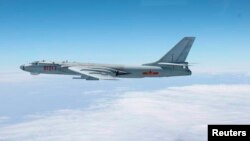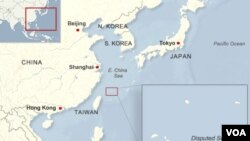BEIJING —
China’s recent announcement that it has established a wide air defense identification zone off its northeastern coast is facing a backlash from the United States, Japan and other allies in the region. But authorities in Beijing are continuing to defend the policy.
China has warned all aircraft to identify themselves and obey orders from Beijing in the new air defense identification zone over the East China Sea.
From the outset, the White House, State Department and Pentagon voiced strong concern about the decision and the threat they say it poses to regional security. On Monday, the U.S. military flew two unarmed B-52 bombers into the zone without notifying China.
South Korea and Japan say they will ignore Beijing's new policy. In Australia, authorities summoned the Chinese ambassador to explain the move.
Newly appointed U.S. Ambassador Caroline Kennedy praised Tokyo’s restraint on Wednesday and warned that China’s actions only serve to increase tensions in region. She also urged the two countries to find a way to resolve the issue through diplomatic channels.
"Japan has shown great restraint this past year and we urge them to continue to do so," she said. "We encourage Japan to increase communications with its neighbors and continue to respond to regional challenges in a measured way."
Carl Thayer, who specializes in Asian maritime security at the Australian Defense Force Academy, says the use of B-52s on what the U.S. military says was a “pre-planned” mission has put more pressure on China.
“I think it puts the ball back in China’s court. You’ve declared the zone and laid out your rules and the United States not only says that it will ignore them but it has ignored them,” he said.
Initial response to the flight from China’s defense ministry was muted.
In a brief statement the ministry said it monitored the entire flights of the planes and identified them in a timely manner. The spokesman repeated again China’s warning that it is capable of exercising effective control over the area in the future.
Foreign Ministry spokesman Qin Gang says China has exercised its legitimate self-defense rights in establishing the zone.
Qin says that China notified relevant countries about the decision before making the announcement and that it is willing to work together with other countries to strengthen communication and maintain regional peace, stability and flight safety.
Analysts note that air defense identification zones were first established in the wake of World War II. The United States established an air defense identification zone in 1950 that required planes to only report to civil authorities when they were heading to the United States, but not when they were passing through.
Thayer says air defense zones were useful in providing assurances during the Cold War with the Soviet Union, but their legal status is ambiguous given that they extend beyond a country’s territorial air space and territorial waters, which the United Nations defines as 12 kilometers from a country's shore.
“These are not zones that are declared when there is an ongoing controversy like there is between China and Japan. China is arguing it is a defensive thing to protect its sovereignty and territorial integrity over its airspace… And the point is that it is not their airspace it is international airspace,” he said.
In China, online commentators have largely welcomed the move as a sign of a more assertive stance in dealing with Japan. At the same time, however, some did note that the zone is different from a country’s airspace and that planes are allowed to enter and exit the zone freely.
According to the new regulations, airplanes entering the zone must identify themselves and follow China’s orders or face potential military action. China also says it reserves the right to announce zones elsewhere as well. Analysts say that could mean that the South China Sea may be next.
What triggered the announcement, however, is still unclear. Some analysts say it is part of Beijing’s ongoing effort to assert its territorial claims in the East and South China Seas. Others say it is a sign that China is no longer going to take a low-key approach to foreign affairs.
Randy Schriver, the head of the Project 2049 Institute in Washington D.C., says it is hard to speculate at this point, but China has clearly been more assertive in recent years.
“There is a sense in China that Japan has not fully embraced the Chinese request to acknowledge a dispute exists. Japan has said it is a political dispute, not a territorial dispute and I think they are trying to ratchet things up in order to put more pressure on Japan,” he said.
Both China and Japan’s air defense zones include the disputed Senkaku or Diaoyu islands as they are known in China.
Japan annexed the islets in the late 19th century. China claimed sovereignty over the archipelago in 1971, saying ancient maps show it has been Chinese territory for centuries.
China has warned all aircraft to identify themselves and obey orders from Beijing in the new air defense identification zone over the East China Sea.
From the outset, the White House, State Department and Pentagon voiced strong concern about the decision and the threat they say it poses to regional security. On Monday, the U.S. military flew two unarmed B-52 bombers into the zone without notifying China.
South Korea and Japan say they will ignore Beijing's new policy. In Australia, authorities summoned the Chinese ambassador to explain the move.
Newly appointed U.S. Ambassador Caroline Kennedy praised Tokyo’s restraint on Wednesday and warned that China’s actions only serve to increase tensions in region. She also urged the two countries to find a way to resolve the issue through diplomatic channels.
"Japan has shown great restraint this past year and we urge them to continue to do so," she said. "We encourage Japan to increase communications with its neighbors and continue to respond to regional challenges in a measured way."
Senkaku Diaoyu Interactive Link
Click here to see an interactive map of the disputed East China Sea islands.“I think it puts the ball back in China’s court. You’ve declared the zone and laid out your rules and the United States not only says that it will ignore them but it has ignored them,” he said.
Initial response to the flight from China’s defense ministry was muted.
In a brief statement the ministry said it monitored the entire flights of the planes and identified them in a timely manner. The spokesman repeated again China’s warning that it is capable of exercising effective control over the area in the future.
Foreign Ministry spokesman Qin Gang says China has exercised its legitimate self-defense rights in establishing the zone.
Qin says that China notified relevant countries about the decision before making the announcement and that it is willing to work together with other countries to strengthen communication and maintain regional peace, stability and flight safety.
Analysts note that air defense identification zones were first established in the wake of World War II. The United States established an air defense identification zone in 1950 that required planes to only report to civil authorities when they were heading to the United States, but not when they were passing through.
Thayer says air defense zones were useful in providing assurances during the Cold War with the Soviet Union, but their legal status is ambiguous given that they extend beyond a country’s territorial air space and territorial waters, which the United Nations defines as 12 kilometers from a country's shore.
“These are not zones that are declared when there is an ongoing controversy like there is between China and Japan. China is arguing it is a defensive thing to protect its sovereignty and territorial integrity over its airspace… And the point is that it is not their airspace it is international airspace,” he said.
In China, online commentators have largely welcomed the move as a sign of a more assertive stance in dealing with Japan. At the same time, however, some did note that the zone is different from a country’s airspace and that planes are allowed to enter and exit the zone freely.
According to the new regulations, airplanes entering the zone must identify themselves and follow China’s orders or face potential military action. China also says it reserves the right to announce zones elsewhere as well. Analysts say that could mean that the South China Sea may be next.
What triggered the announcement, however, is still unclear. Some analysts say it is part of Beijing’s ongoing effort to assert its territorial claims in the East and South China Seas. Others say it is a sign that China is no longer going to take a low-key approach to foreign affairs.
Randy Schriver, the head of the Project 2049 Institute in Washington D.C., says it is hard to speculate at this point, but China has clearly been more assertive in recent years.
“There is a sense in China that Japan has not fully embraced the Chinese request to acknowledge a dispute exists. Japan has said it is a political dispute, not a territorial dispute and I think they are trying to ratchet things up in order to put more pressure on Japan,” he said.
Both China and Japan’s air defense zones include the disputed Senkaku or Diaoyu islands as they are known in China.
Japan annexed the islets in the late 19th century. China claimed sovereignty over the archipelago in 1971, saying ancient maps show it has been Chinese territory for centuries.










